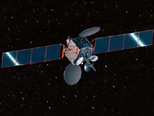 | |
| Names | AsiaSat 3 HGS-1 PAS-22 |
|---|---|
| Mission type | Communications |
| Operator | AsiaSat (1997–1998) Hughes (1998–1999) PanAmSat (1999–2002) |
| COSPAR ID | 1997-086A |
| SATCAT no. | 25126 |
| Mission duration | 15 years (planned) [1]
4 years (achieved) |
| Spacecraft properties | |
| Spacecraft | AsiaSat 3 |
| Spacecraft type | Boeing 601 |
| Bus | HS-601HP |
| Manufacturer | Hughes Space and Communications |
| Launch mass | 3,465 kg[2] |
| Dry mass | 2,500 kg (5,500 lb) |
| Dimensions | 3.4 m x 3.5 m x 5.8 m Span: 26.2 m on orbit |
| Power | 9.9 kW |
| Start of mission | |
| Launch date | 24 December 1997, 23:19:00 UTC[3] |
| Rocket | Proton-K / DM-2M |
| Launch site | Baikonur, Site 81/23 |
| Contractor | Khrunichev State Research and Production Space Center |
| Entered service | July 1998 |
| End of mission | |
| Disposal | Graveyard orbit |
| Deactivated | July 2002 |
| Orbital parameters | |
| Reference system | Geocentric orbit |
| Regime | Geostationary orbit |
| Longitude | 105.5° East (intended) 158° West (1998-1999) 62° West (1999–2002) [4] |
| Flyby of Moon | |
| Closest approach | 13 May 1998, 19:00 UTC [5] |
| Distance | 6,200 km (3,900 mi) |
| Flyby of Moon | |
| Closest approach | 6 June 1998, 16:30 UTC |
| Distance | 34,300 km (21,300 mi) |
| Transponders | |
| Band | 44 transponders: 28 C-band 16 Ku-band |
| Coverage area | Asia |
AsiaSat 3, previously known as HGS-1 and then PAS-22, was a geosynchronous communications satellite, which was salvaged from an unusable geosynchronous transfer orbit (GTO) by means of the Moon's gravity.
- ^ "AsiaSat-3, -3S / HGS-1 / PAS-22". Gunter's Space Page. Retrieved 15 May 2010.
- ^ "AsiaSat 3 → HGS-1 → PAS-22". NASA's Solar System Exploration website. Retrieved 1 December 2022.
- ^ "Launch Log". Jonathan's Space Report. 14 March 2021. Retrieved 3 May 2021.
- ^ Cite error: The named reference
TSEwas invoked but never defined (see the help page). - ^ "AsiaSat 3". Retrieved 15 May 2010.